Rank insignia
Badges of rank are usually worn on the epaulettes. However, when in their formal uniform sergeants wear their rank insignia on their upper sleeves. [6] [7] When police tunics had closed collars (not open collars as worn with ties), constables and sergeants did not wear epaulettes but had their divisional call number on their collar (hence they are still often referred to as collar numbers). Sergeants wore their stripes on their upper sleeve. Inspectors and more senior ranks wore epaulettes at a much earlier stage, although they once wore their rank insignia on their collars. Most forces no longer use divisional call numbers, and retain only the collar number and rank insignia.
Great Britain
Senior officers usually wear distinguishing marks around the outer edge of the peaks of their caps (or under the capbadge for female officers, who do not wear peaked caps). Normally this is a raised black band for inspectors and chief inspectors, a silver (gold in the City of London Police) band for superintendents and chief superintendents, and a row of silver oak leaves for chief officers. Chief constables, the Commissioner of the City of London Police, and all commissioner ranks of the Metropolitan Police wear oak leaves on both the outer and inner edges of their peaks (or a double row beneath the capbadge for female officers). In Scotland, however, the mark is a silver band for inspectors and chief inspectors, a silver band and silver oak leaves on the outer and inner edges of the peak respectively for superintendents and chief superintendents, and silver oak leaves on the outer and inner edges of the peak for all chief officers.
Additionally, officers at or above the rank of commander or assistant chief constable wear gorget patches on the collars of their tunics. The gorget patches are patterned after those worn by general officers of the British Army and Royal Marines; the police versions, however, are of silver on black (gold on black in the City of London Police) rather than gold on red, in keeping with the police uniform colours.
The ranks below are used by all territorial forces in the United Kingdom, and the specialist national forces: the British Transport Police, Ministry of Defence Police, and Civil Nuclear Constabulary. [15] Other specialist forces, and those outside of the United Kingdom (including British Overseas Territories such as Bermuda and Gibraltar, which are parts of the British sovereign territory in most of which internal competencies of governance are mostly delegated to local governments, and the Crown Dependencies of the Channel Islands and the Isle of Man, which are not parts of the British sovereign territory) use the same general system, but often have fewer senior ranks.
Chief constable is the title of the head of each United Kingdom territorial police force except the Metropolitan Police and City of London Police, which are headed by commissioners. Ranks above chief superintendent are usually non-operational management roles, and are often referred to as "chief officer" ranks, but the longer phrase "chief police officer" or similar in legislation is specifically a commissioner or chief constable, a "senior police officer" being their immediate deputy. [16] The Commissioner of the Metropolitan Police is often considered to be the highest police rank within the United Kingdom, [17] although in reality every chief constable and the two commissioners are supreme over their own forces and are not answerable to any other officer. [18] [ citation needed ]
Epaulettes are normally black with white sewn on or silver metal insignia, although high-visibility uniforms are often yellow with black insignia.
Epaulette insignia
| Rank | Chief constable | Deputy chief constable | Assistant chief constable | Chief superintendent | Superintendent | Chief inspector | Inspector | Sergeant | Constable |
|---|---|---|---|---|---|---|---|---|---|
| Epaulette insignia |  |  |  |  |  |  |  |  |  |
Uniform insignia
The rank of an officer can be found in varying details of the uniform such as headgear, sleeve patches and tunic collar details.
Insignia on hats and uniforms can vary between forces within the UK and the following tables below will not accurately represent all constabularies within the UK.
| Rank | Chief constable | Deputy chief constable | Assistant chief constable | Chief superintendent | Superintendent | Chief inspector | Inspector | Sergeant | Constable | ||
|---|---|---|---|---|---|---|---|---|---|---|---|
| Commissioner | Deputy commissioner | Assistant commissioner | Deputy assistant commissioner | Commander | |||||||
| Uniform insignia |  |  |  |  |  | ||||||
| Note |
| ||||||||||
| Rank | Chief constable | Deputy chief constable | Assistant chief constable | Chief superintendent | Superintendent | Chief inspector | Inspector | Sergeant | Constable | Police community support officer | |||
|---|---|---|---|---|---|---|---|---|---|---|---|---|---|
| Commissioner | Deputy commissioner | Assistant commissioner | Deputy assistant commissioner | Commander | |||||||||
| Female patrol | | | | | | ||||||||
| Female traffic officer | | | |||||||||||
| Male foot patrol | | | | |  | | |||||||
| Male mobile patrol | | ||||||||||||
| Male traffic officer | | | |||||||||||
| Notes |
| ||||||||||||
British Transport Police
As a variation to the standard set, the deputy chief constable of the British Transport Police wears two rows of oak leaves on their hat. [19]
Northern Ireland
The Police Service of Northern Ireland (PSNI) adopted the same rank system as elsewhere in the United Kingdom on 1 June 1970, but has a different version of the rank insignia, with the star from the PSNI badge replacing the crown. [20] Unusually, the star is worn below the pip by chief superintendents and by the chief constable, who wears both symbols above his tipstaves. The PSNI has retained the RUC's distinctive inverted (point-up) sergeants' chevrons, worn on the lower sleeve in formal uniform. PSNI officers do not wear the custodian helmet and female officers wear a different hat from other forces.
The PSNI rank structure and epaulette insignia is the same as the territorial police in Great Britain, except that the crown is replaced with the design from the PSNI badge and sergeants' chevrons are point up. In addition to the epaulettes being a green colour rather than a black, this is to match their green uniforms.
| Rank | Chief constable | Deputy chief constable | Assistant chief constable | Chief superintendent | Superintendent | Chief inspector | Inspector | Sergeant | Constable |
|---|---|---|---|---|---|---|---|---|---|
| Epaulette insignia |  |  |  |  |  |  |  |  |  |
Headgear rank marking is the same as for England and Wales.
Scotland
Police Scotland headwear is slightly different for the following ranks:
Territorial police forces variations
City of London Police
| Rank | Commissioner | Deputy commissioner | Commander | Chief superintendent | Superintendent | Chief inspector | Inspector | Sergeant | Constable |
|---|---|---|---|---|---|---|---|---|---|
| Insignia |  | 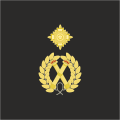 |  | 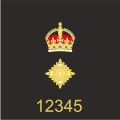 |  | 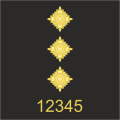 |  | 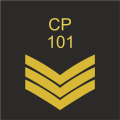 |  |
| Note |
| ||||||||
City of London Police insignia are gold where that of other forces is silver. For example, rank insignia and collar numbers on epaulettes are gold, as are the bands and oak leaves on the caps of senior officers, [24] and officers of or above the rank of commander wear gold-on-black gorget patches on the collars of their tunics.
The City of London Police also previously had variations for some acting ranks such as sergeant and inspector: acting sergeants wore their chevrons above their divisional letters (or later "CP" for all officers, following the abolition of the force's divisions), whereas substantive sergeants wear them below their collar numbers. Acting inspectors were denoted by a crown in the place of their divisional letters, whilst keeping their collar number and chevrons.[ citation needed ]
The City of London Police use a different colour scheme for their police headwear. Instead of the black and white sillitoe tartan they use red and white. The assistant commissioner and commander wear a single row of oak leaves on their hats, [25] [26] and only the commissioner wears two rows. [27]
Merseyside Police
Inspectors and chief inspectors in Merseyside Police wear silver instead of black lace on their hats, [28] as did Liverpool City Police before them.
Metropolitan Police
The Metropolitan Police uses different ranks above chief superintendent. The fabric used in the crowns is blue, whereas other police forces use red. Although they rank as deputy chief constables, deputy assistant commissioners wear two rows of oak leaves on their hats. [29] [30]
Isle of Man Constabulary
Epaulette insignia
The Isle of Man police ranks follow the structure of other British police rank structures however it is notably missing the chief superintendent and assistant chief constable ranks within their own structure. The epaulettes for the constables and sergeants also have an addition of the Isle of Man Constabulary logo and motto above their collar numbers. Headgear rank marking is the same as for England and Wales.
| Rank | Chief constable | Deputy chief constable | Superintendent | Chief inspector | Inspector | Sergeant | Constable |
|---|---|---|---|---|---|---|---|
| Epaulette insignia |  |  |  |  |  |  |  |
Special constabularies insignia
Special constabulary epaulettes frequently bear the letters SC (with or without a crown above) to differentiate them from regular officers. Within the City of London Special Constabulary is the Honourable Artillery Company Specials; members of this unit wear HAC on the shoulders in addition to other insignia. [31] Senior special constables wear the same markings on their hats as equivalent regular ranks.
| Constabulary | Chief officer | Deputy chief officer | Special superintendent | Special chief inspector | Special inspector | Special sergeant | Special constable | Notes |
|---|---|---|---|---|---|---|---|---|
| Durham Special Constabulary [32] |  |  |  |  |  |  |
| |
| Hampshire Special Constabulary [33] |  |  |  |  |  |
| ||
| Kent Special Constabulary |  |  |  |  |  |  |
| |
| Merseyside Special Constabulary [34] |  |  |  |  |  | |||
| Northamptonshire Special Constabulary [35] |  |  |  |  | ||||
| South Wales Special Constabulary [36] |  |  |  |  |  |
| ||
| South Yorkshire Special Constabulary [37] |  |  |  |  |  |  | ||
| Wiltshire Special Constabulary [38] |  |  |  |  | ||||
| Gloucestershire Special Constabulary [39] |  |  |  |  |  |
| ||
| City of London Special Constabulary |  | 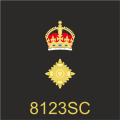 |  |  |  | 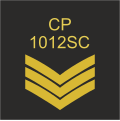 |  |
|
| Notes |
| |||||||
There is a large variation in the design of epaulettes used across Great Britain for specials. This has been recognised at national level and as part of the Special Constabulary National Strategy 2018–2023 the structure and insignia is under review with the intention to standardise. [40] Other special constabularies use combinations of bars, half bars, pips, crowns, laurel wreaths, collar numbers, force crests and the SC identity (with or without a crown) to distinguish ranks (and/or role).
| Constabulary | Chief officer | Deputy chief officer | Assistant chief officer | Special chief superintendent | Special superintendent | Special chief inspector | Special inspector | Special sergeant | Special constable | Notes |
|---|---|---|---|---|---|---|---|---|---|---|
| Avon and Somerset Special Constabulary [41] |  |  |  |  |  |  | ||||
| Bedfordshire Special Constabulary [42] |  |  |  |  |  | |||||
| British Transport Police [43] |  |  |  |  |  |  | ||||
| Cambridgeshire Special Constabulary [44] |  |  |  |  |  |  |  | |||
| Cheshire Special Constabulary [45] |  |  |  |  |  |  |  | |||
| Cleveland Special Constabulary [46] |  |  |  |  |  |  | ||||
| Cumbria Special Constabulary [47] |  |  |  |  |  |  |
| |||
| Derbyshire Special Constabulary [48] |  |  |  | |||||||
| Devon and Cornwall Special Constabulary [49] |  |  |  |  |  | |||||
| Dorset Special Constabulary [50] |  |  |  |  |  |  | ||||
| Dyfed-Powys Special Constabulary [51] |  |  |  |  |  | |||||
| Essex Special Constabulary [52] |  |  |  |  |  | |||||
| Gloucestershire Special Constabulary [53] |  |  |  |  |  | |||||
| Greater Manchester Special Constabulary [54] |  |  |  |  |  | |||||
| Gwent Special Constabulary [55] |  |  |  |  |  | |||||
| Hertfordshire Special Constabulary [56] |  |  |  |  |  |  | ||||
| Constabulary | Chief officer | Deputy chief officer | Assistant chief officer | Special chief superintendent | Special superintendent | Special chief inspector | Special inspector | Special sergeant | Special constable | Notes |
| Lancashire Special Constabulary [57] |  |  |  |  |
| |||||
| Leicestershire Special Constabulary [58] |  |  |  |  |
| |||||
| Lincolnshire Special Constabulary [59] |  |  |  |  | ||||||
| Metropolitan Special Constabulary [60] |  |  |  |  |  |  | ||||
| Norfolk Special Constabulary [61] |  |  |  |  |  |  | ||||
| Northumbria Special Constabulary [62] |  |
| ||||||||
| North Wales Special Constabulary [63] |  |  |  |  |  | |||||
| Nottinghamshire Special Constabulary [64] |  |  |  |  |  | |||||
| Police Scotland [65] |  |
| ||||||||
| Staffordshire Special Constabulary [66] |  |  |  |  |  |  | ||||
| Suffolk Special Constabulary [67] |  |  |  |  |  |  | ||||
| Surrey Special Constabulary |  | |  | |||||||
| Thames Valley Special Constabulary [68] |  |  |  |  |  |  |  |
| ||
| Warwickshire Special Constabulary [69] |  |  |  |  |  |  | ||||
| West Mercia Special Constabulary [70] |  |  |  |  |  |  | ||||
| West Midlands Special Constabulary [71] |  |  |  |  |  | |||||
| West Yorkshire Special Constabulary [72] |  |  |  |  |
| |||||
| Constabulary | Chief officer | Deputy chief officer | Assistant chief officer | Special chief superintendent | Special superintendent | Special chief inspector | Special inspector | Special sergeant | Special constable | Notes |
| Notes |
| |||||||||
Miscellaneous police forces
There are, in the United Kingdom, a number of miscellaneous constabularies. These are not operated, regulated or funded by the Home Office, although they are fully authorised (by Act of Parliament) establishments. In general, they provide the policing for ports, docks, tunnels, or other particular institutions. Although these forces tend to require high standards of training and accountability, which closely mirror those of the Home Office police forces, they are usually much smaller in terms of personnel, and therefore utilise fewer of the 'standard' ranks.
Public order roles and rank insignia
Officers taking part in public order and public safety (POPS) events and incidents wear colour-coded rank slides to denote command and support roles. Bronze commanders can be of varying ranks and not just chief inspectors as shown below. Tactical advisers can also be of differing ranks, but are most commonly constables or sergeants. It is a requirement under the College of Policing Public Order Manual that all officers, regardless of rank, display an identifying number on their epaulettes. Therefore, ranks such as inspector have collar/warrant numbers displayed on their public order colour-coded epaulettes that they might not have as part of their normal uniform.
| Role | Bronze commander | PSU commander | Serial sergeant | Evidence gathering team | Medic | Tactical advisor | Serial constable | |
|---|---|---|---|---|---|---|---|---|
| Epaulette insignia |  |  |  |  |  |  |  | |
| Variants |  |  |  |  |  | |||
Police community support officers (PCSO)
Police community support officers bear epaulettes with the words "Police community support officer" and their shoulder number, or, in the Metropolitan Police, a borough identification code and shoulder number. South Yorkshire Police PCSO supervisors wear a bar above the words "Police community support officer supervisor" and the shoulder number.
- Variations of PCSO epaulettes varying between forces
- Examples of PCSO supervisor epaulettes
- Examples of PCSO epaulettes in the City of London Police
Police cadets

The following table serves as an example of ranks within volunteer police cadet schemes, which vary considerably. Cadets appointed "mayor's cadets" are given a special badge or epaulettes to wear.
| Cadet service | Cadet under officers | Cadet senior NCOs | Cadet junior NCOs | Cadets | Recruits | |||||||
|---|---|---|---|---|---|---|---|---|---|---|---|---|
Metropolitan volunteer police cadets | ||||||||||||
 |  |  |  |  | No insignia | |||||||
| No equivalent | Head cadet | No equivalent | Deputy head cadet | No equivalent | Team leader cadet | Deputy team leader cadet | Police cadet | Recruit | ||||
| HCdt | DHCdt | TLCdt | DTLCdt | Cdt | Rct | |||||||
Hampshire volunteer police cadets | ||||||||||||
 |  |  |  | No insignia | ||||||||
| No equivalent | Head cadet | No equivalent | Deputy head cadet | No equivalent | Team leader cadet | No equivalent | Police cadet | Recruit | ||||
| HCdt | DHCdt | TLCdt | Cdt | Rct | ||||||||






















